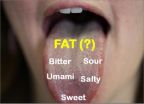(Press-News.org) Why do we like fatty foods so much? We can blame our taste buds.
Our tongues apparently recognize and have an affinity for fat, according to researchers at Washington University School of Medicine in St. Louis. They have found that variations in a gene can make people more or less sensitive to the taste of fat.
The study is the first to identify a human receptor that can taste fat and suggests that some people may be more sensitive to the presence of fat in foods. The study is available online in the Journal of Lipid Research.
Investigators found that people with a particular variant of the CD36 gene are far more sensitive to the presence of fat than others.
"The ultimate goal is to understand how our perception of fat in food might influence what foods we eat and the quantities of fat that we consume," says senior investigator Nada A. Abumrad, PhD, the Dr. Robert A. Atkins Professor of Medicine and Obesity Research. "In this study, we've found one potential reason for individual variability in how people sense fat. It may be, as was shown recently, that as people consume more fat, they become less sensitive to it, requiring more intake for the same satisfaction. What we will need to determine in the future is whether our ability to detect fat in foods influences our fat intake, which clearly would have an impact on obesity."
People who made more CD36 protein could easily detect the presence of fat. In fact, study subjects who made the most CD36 were eight times more sensitive to the presence of fat than those who made about 50 percent less of the protein.
The researchers studied 21 people with a body mass index (BMI) of 30 or more, which is considered to be obese. Some participants had a genetic variant that led to the production of more CD36. Others made much less. And some were in between.
Participants were asked to taste solutions from three different cups. One contained small amounts of a fatty oil. The other two contained solutions that were similar in texture to the oil but were fat-free. Subjects were asked to choose the cup that was different.
"We did the same three-cup test several times with each subject to learn the thresholds at which individuals could identify fat in the solution," explains first author M. Yanina Pepino, PhD, research assistant professor of medicine. "If we had asked, 'does it taste like fat to you?' that could be very subjective. So we tried to objectively measure the lowest concentration of fat at which someone could detect a difference."
Her team masked input that might help participants identify fat by sight or smell. To eliminate visual cues, they lit the testing area with a red lamp. Study subjects also wore nose clips so that they could not smell the solutions.
Fat is an important component of the diet, and both humans and animals usually prefer high-fat, energy-dense foods. Scientists have believed that people identify those high-fat foods mainly by texture, but this study suggests that the presence of fat can change the way our tongues perceive the food, just as it does for the tastes sweet, sour, bitter, salty and savory (umami).
AUDIO:
Washington University researchers are the first to identify a potential human receptor for tasting fat. In a series of taste tests, they've found that people can identify fat in a...
Click here for more information.
The CD36 discovery follows research that had identified a role for the gene in rats and mice. Scientists had learned that when animals are genetically engineered without a working CD36 gene, they no longer display a preference for fatty foods. In addition, animals that can't make the CD36 protein have difficulty digesting fat.
Up to 20 percent of people are believed to have the variant in the CD36 gene that is associated with making significantly less CD36 protein. That, in turn, could mean they are less sensitive to the presence of fat in food.
Abumrad was the first to identify CD36 as the protein that facilitates the uptake of fatty acids. She says better understanding of how the protein works in people could be important in the fight against obesity.
People with obesity are at an elevated risk for cardiovascular disease, stroke, type 2 diabetes, certain cancers, arthritis and other problems. Obesity rates have risen dramatically over the past 30 years as more people have become sedentary, and diets incorporate more hamburgers, French fries, fried chicken and other high-fat foods.
"Diet can affect sensitivity to fat, and in animals, diet also influences the amount of CD36 that's made," Pepino says. "If we follow the results in animals, a high-fat diet would lead to less production of CD36, and that, in turn, could make a person less sensitive to fat. From our results in this study, we would hypothesize that people with obesity may make less of the CD36 protein. So it would seem logical that the amounts of the protein we make can be modified, both by a person's genetics and by the diet they eat."
Our diet contains fat, mainly in the form of triglycerides, which are made of fatty acids linked to glyerol. In the tast test, the researchers presented subjects with two types of fat. Some cups contained a free fatty acid. Others contained triglyerides.
Pepino and Abumrad knew from animal studies that CD36 is activated by fatty acids but not triglycerides. Human subjects, however, were able to taste both. Pepino believes that's probably due to the activity of an enzyme called lipase in the saliva that breaks the triglycerides, releasing the fatty acids while the fat is still in the mouth.
"Rats, for example, can produce salivary lipase, and the lipase quickly will begin to digest the triglyceride and convert it into a fatty acid," she explains. "In humans, the role of lipase hasn't been as clear. In our experiments, people could detect fat whether it was a triglyceride or a fatty acid."
But when the researchers added the diet drug orlistat, subjects could still taste the fatty acids but were less able to detect the triglycerides. Orlistat inhibits lipase in the mouth, stomach and intestine and is often prescribed to people who are obese to prevent them from absorbing fat in foods.
"Orlistat made it more difficult for people to taste fat," Pepino says. "The solution had to contain higher amounts of triglyceride before they could detect fat. With free fatty acid, however, there was no difference."
INFORMATION:
Pepino MY, Love-Gregory L, Klein S, Abumrad NA, The fatty acid translocase gene, CD36, and lingual lipase influence oral sensitivity to fat in obese subjects. Journal of Lipid Research, Dec. 31, 2011 [Epub ahead of print].
Funding for this research comes from the National Center for Research Resources and the National Institute of Diabetes and Digestive and Kidney Diseases of the National Institutes of Health (NIH), and by a grant from GlaxoSmithKline Consumer Healthcare Research Program.
Washington University School of Medicine's 2,100 employed and volunteer faculty physicians also are the medical staff of Barnes-Jewish and St. Louis Children's hospitals. The School of Medicine is one of the leading medical research, teaching and patient care institutions in the nation, currently ranked fourth in the nation by U.S. News & World Report. Through its affiliations with Barnes-Jewish and St. Louis Children's hospitals, the School of Medicine is linked to BJC HealthCare.
Receptor for tasting fat identified in humans
2012-01-13
ELSE PRESS RELEASES FROM THIS DATE:
Research team discovers genes and disease mechanisms behind a common form of muscular dystrophy
2012-01-13
SEATTLE – Continuing a series of groundbreaking discoveries begun in 2010 about the genetic causes of the third most common form of inherited muscular dystrophy, an international team of researchers led by a scientist at Fred Hutchinson Cancer Research Center has identified the genes and proteins that damage muscle cells, as well as the mechanisms that can cause the disease. The findings are online and will be reported in the Jan. 17 print edition of the journal Developmental Cell.
The discovery could lead to a biomarker-based test for diagnosing facioscapulohumeral muscular ...
Planets around stars are the rule rather than the exception
2012-01-13
LIVERMORE, Calif. --There are more exoplanets further away from their parent stars than originally thought, according to new astrophysics research.
In a new paper appearing in the Jan. 12 edition of the journal, Nature, astrophysicist Kem Cook as part of an international collaboration, analyzed microlensing data that bridges the gap between a recent finding of planets further away from their parent stars and observations of planets extremely close to their parent star. The results point to more planetary systems resembling our solar system rather than being significantly ...
ONR's information discovery and sharing environment undergoes 'Marathon' experiment
2012-01-13
The ability to catch international smugglers and terrorists just got upgraded with a Jan. 12 demonstration of collaborative software funded by the Office of Naval Research (ONR).
The Mission-Focused Autonomy (MFA) program was put into practice for the Joint Interagency Task Force (JIATF) South in Key West, Fla., during an exercise dubbed "Marathon." The collaborative information discovery and knowledge-sharing tools sift through government agency databases to support efforts by federal law enforcement for information on foreign nationals intent on harming national security ...
Largest bird alters its foraging due to climate change
2012-01-13
Paris/ Leipzig. Wandering albatrosses have altered their foraging due to changes in wind fields in the southern hemisphere during the last decades. Since winds have increased in intensity and moved to the south, the flight speed of albatrosses increased and they spend less time foraging. As a consequence, breeding success has improved and birds have gained 1 kilogram. These are the results of the study of an international research team published in the latest issue of the Science journal. However, these positive consequences of climate change may last short if future wind ...
Graphene quantum dots: The next big small thing
2012-01-13
A Rice University laboratory has found a way to turn common carbon fiber into graphene quantum dots, tiny specks of matter with properties expected to prove useful in electronic, optical and biomedical applications.
The Rice lab of materials scientist Pulickel Ajayan, in collaboration with colleagues in China, India, Japan and the Texas Medical Center, discovered a one-step chemical process that is markedly simpler than established techniques for making graphene quantum dots. The results were published online this month in the American Chemical Society's journal Nano ...
Deaf sign language users pick up faster on body language
2012-01-13
Deaf people who use sign language are quicker at recognizing and interpreting body language than hearing non-signers, according to new research from investigators at UC Davis and UC Irvine.
The work suggests that deaf people may be especially adept at picking up on subtle visual traits in the actions of others, an ability that could be useful for some sensitive jobs, such as airport screening.
"There are a lot of anecdotes about deaf people being better able to pick up on body language, but this is the first evidence of that," said David Corina, professor in the UC ...
How the brain routes traffic for maximum alertness
2012-01-13
A new UC Davis study shows how the brain reconfigures its connections to minimize distractions and take best advantage of our knowledge of situations.
"In order to behave efficiently, you want to process relevant sensory information as fast as possible, but relevance is determined by your current situation," said Joy Geng, assistant professor of psychology at the UC Davis Center for Mind and Brain.
For example, a flashing road sign alerts us to traffic merging ahead; or a startled animal might cue you to look out for a hidden predator.
When concentrating on a specific ...
Breakthrough model reveals evolution of ancient nervous systems through seashell colors
2012-01-13
PITTSBURGH—Determining the evolution of pigmentation patterns on mollusk seashells—which could aid in the understanding of ancient nervous systems—has proved to be a challenging feat for researchers. Now, however, through mathematical equations and simulations, University of Pittsburgh and University of California, Berkeley, researchers have used 19 different species of the predatory sea snail Conus to generate a model of the pigmentation patterns of mollusk shells.
"There is no evolutionary record of nervous systems, but what you're seeing on the surface of seashells ...
Study finds chlorophyll can help prevent cancer - but questions traditional research methods
2012-01-13
CORVALLIS, Ore. – A recent study at Oregon State University found that the chlorophyll in green vegetables offers protection against cancer when tested against the modest carcinogen exposure levels most likely to be found in the environment.
However, chlorophyll actually increases the number of tumors at very high carcinogen exposure levels.
Beyond confirming the value of chlorophyll, the research raises serious questions about whether traditional lab studies done with mice and high levels of toxic exposure are providing accurate answers to what is a real health risk, ...
Anthrax capsule vaccine protects monkeys from lethal infection
2012-01-13
Vaccination with the anthrax capsule—a naturally occurring component of the bacterium that causes the disease—protected monkeys from lethal anthrax infection, according to U.S. Army scientists. The study, which appears in the Jan. 20th print edition of the journal VACCINE, represents the first successful use of a non-toxin vaccine to protect monkeys from the disease.
Bacillus anthracis, the bacterium that causes anthrax, is recognized as one of the most serious bioterrorism threats. It produces three main components that allow it to do harm—lethal toxin, edema toxin, ...


